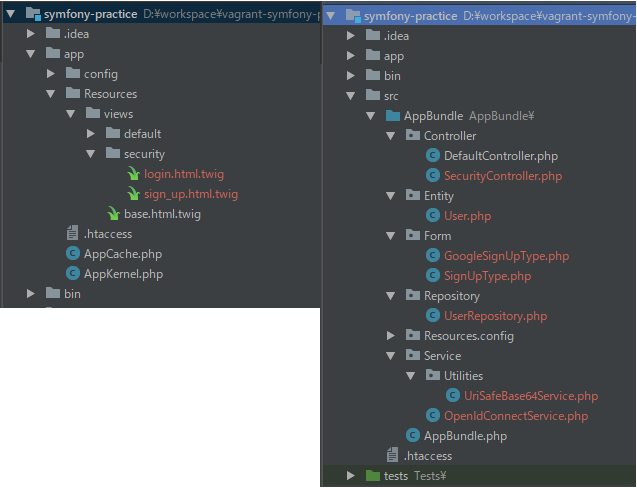Symfony3でソーシャルログインの機能を実装してみました。
今回はGoogleのアカウントでログインできるようにしてみます。
画面上の流れ
環境
- Symfony3.3
- PHP7.1
- MariaDB10.2
OpenID Connectのフロー
OpenID Connectで使われているフローは以下の3つです。
- Authorization Code Flow
- Implicit Flow
- Hybrid Flow
今回はAuthorization Code Flowで実装してきます。
参考: http://openid.net/specs/openid-connect-core-1_0.html#Authentication
事前準備
Googleの設定
以下ページの「Setting up OAuth 2.0」を終わらせている。(認証情報、クライアントID等の取得)
https://developers.google.com/identity/protocols/OpenIDConnect#appsetup
Symfony
プロジェクトの作成
以下ページにしたがってプロジェクトを作成する。
https://symfony.com/doc/3.4/setup.html
ログイン
以下ページを参考にログインを実装する。
https://symfony.com/doc/3.4/security/form_login_setup.html
https://symfony.com/doc/3.4/security/entity_provider.html
サインアップ
以下ページを参考にサインアップを実装する。
https://symfony.com/doc/3.4/doctrine/registration_form.html
サインアップ画面のtwigは以下のようにしておきます。
{% extends 'base.html.twig' %}
{% block body %}
{{ form_start(form) }}
{{ form_widget(form) }}
<button type="submit">sign up</button>
{{ form_end(form) }}
{% endblock %}
ディレクトリ構成
参考: https://symfony.com/doc/3.4/best_practices/creating-the-project.html#structuring-the-application
実装
設定
sessionの保存場所をPHPのsession保存先に変更します。
※以下設定はPHPのデフォルトでsessionが保存される場所を指定しています。
framework:
session:
save_path: '/var/lib/php/session/%kernel.environment%'
ルーティング
ルーティングを以下のように定義します。
sign_up:
path: /sign_up
defaults: { _controller: AppBundle:Security:signUp }
login:
path: /login
defaults: { _controller: AppBundle:Security:login }
logout:
path: /logout
google:
path: /auth/google
defaults: { _controller: AppBundle:Security:googleLogin }
redirect_google:
path: /google
defaults: { _controller: AppBundle:Security:redirectGoogleLogin }
google_sign_up:
path: /google_sign_up
defaults: { _controller: AppBundle:Security:googleSignUp }
security.yml
security.ymlを以下のように定義します。
security:
access_control:
- { path: ^/login, roles: IS_AUTHENTICATED_ANONYMOUSLY }
- { path: ^/sign_up, roles: IS_AUTHENTICATED_ANONYMOUSLY }
- { path: ^/auth/*, roles: IS_AUTHENTICATED_ANONYMOUSLY }
- { path: ^/google, roles: IS_AUTHENTICATED_ANONYMOUSLY }
- { path: ^/, roles: ROLE_USER }
ログイン画面にリンクを追加
ログイン画面のtwigにGoogleアカウントでログインする用のリンクを追記します。
{% block body %}
//省略
<a href="{{ path('google') }}">Sign in By Google</a>
{% endblock %}
Userテーブルにsubjectカラムを追加
OpenID Connectで使用するため、Userテーブルにsubjectカラムを追加します。
EntityのUserクラスに以下を追記します。
class User implements UserInterface, \Serializable
{
//省略
/**
* @ORM\Column(type="string", length=255, unique=true, nullable=true)
*/
private $subject;
//省略
}
以下コマンドを実行します。
php bin/console doctrine:generate:entities AppBundle/Entity/User
php bin/console doctrine:schema:update --force
OpenID Connect
ここから以下のサイトを参考にOpenID Connectでログインできるように実装していきます。
https://developers.google.com/identity/protocols/OpenIDConnect#authenticatingtheuser
実装ベースでのAuthorization Code Flowの流れは以下です。
Ⅰ. GoogleのAuthorization Endpointに認証リクエストを送信
Ⅱ. GoogleのToken Endpointにリクエストを送信
Ⅲ. 取得したID Tokenから情報を取得
Ⅰ. GoogoleのAuthorization Endpointに認証リクエストを送信
1. Create an anti-forgery state token
CSRF対策トークンを作成するところですが、今回はSymfonyのメソッドを使ってsessionに保存しています。
class SecurityController extends Controller
{
public function googleLoginAction(Request $request)
{
$session = $request->getSession();
$uriSafeTokenGenerator = new UriSafeTokenGenerator();
$state = $uriSafeTokenGenerator->generateToken();
$session->set('state', $state);
}
}
2. Send an authentication request to Google
GoogleのAuthorization Endpointに認証リクエストを送ります。
class SecurityController extends Controller
{
public function googleLoginAction(Request $request)
{
//省略
$url = "https://accounts.google.com/o/oauth2/v2/auth?"
. "client_id=xxxxxx.apps.googleusercontent.com&" //取得したクライアントID
. "response_type=code&" //Authorization Code Flowなので
. "scope=openid%20email&" //取得したい情報を指定する
. "redirect_uri=http://localhost/google&" //リダイレクトされるURL
. "state=$state&" //先ほど作ったstate
. "prompt=select_account&"
. "nonce=0394852-3190485-2490358&"; //リプレイアタック対策用
return $this->redirect($url);
}
}
Ⅱ. GoogleのToken Endpointにリクエストを送信
3. Confirm anti-forgery state token
認証後リダイレクトされるのでstateの検証を行います。
class SecurityController extends Controller
{
public function redirectGoogleLoginAction(Request $request)
{
if ($request->query->get('state') != $request->getSession()->get('state')) {
return new Response('Invalid state parameter', 401);
}
}
}
4. Exchange code for access token and ID token
stateの確認後、取得したAuthorization Codeを使ってToken EndpointにPOSTします。
成功するとレスポンスボディにAccess TokenとID Tokenが含まれたJSONがかえってきます。
class SecurityController extends Controller
{
private $openIdConnectService;
public function __construct(OpenIdConnectService $openIdConnectService)
{
$this->openIdConnectService = $openIdConnectService;
}
public function redirectGoogleLoginAction(Request $request)
{
// 省略
$token = $this->openIdConnectService->getToken($request->query->get('code'));
}
}
class OpenIdConnectService
{
public function getToken($code)
{
$postData = array(
'code' => $code, //取得したAuthorization Code
'client_id' => 'xxxxxx.apps.googleusercontent.com',
'client_secret' => 'xxxxxx',
'redirect_uri' => 'http://localhost/google',
'grant_type' => 'authorization_code'
);
$curlOpts = array(
CURLOPT_URL => "https://www.googleapis.com/oauth2/v4/token",
CURLOPT_HEADER => array("Content-type: application/x-www-form-urlencoded"),
CURLOPT_POST => true,
CURLOPT_POSTFIELDS => http_build_query($postData),
CURLOPT_RETURNTRANSFER => true
);
$ch = curl_init();
curl_setopt_array($ch, $curlOpts);
$response = curl_exec($ch);
$headerSize = curl_getinfo($ch, CURLINFO_HEADER_SIZE);
$body = substr($response, $headerSize);
curl_close($ch);
return json_decode($body, true);
}
}
Ⅲ. 取得したID Tokenから情報を取得
5. Obtain user information from the ID token
OpenID ConnectではID Tokenの検証は必須ですが、
HTTPSを使って直接Googleと通信をし、自分のclient secretを使っていれば
検証する必要はないらしいです。
ID TokenはJWTという形式で、.が区切り文字になっています。
その区切られた2番目の文字列をPayloadと言い、Googleから送られてきたemailなどの値が入っています。
PayloadはBase64でエンコードされていて、デコードするとJSONが出てきます。
参考: https://tools.ietf.org/html/rfc7519#section-3.1
Payloadの中のSubを使って登録済みかを判定し、
登録済みだった場合、ログイン状態へ、
登録済みではなかった場合、リダイレクトしています。
class SecurityController extends Controller
{
private $openIdConnectService;
private $uriSafeBase64Service;
public function __construct(OpenIdConnectService $openIdConnectService, UriSafeBase64Service $uriSafeBase64Service)
{
$this->openIdConnectService = $openIdConnectService;
$this->uriSafeBase64Service = $uriSafeBase64Service;
}
public function redirectGoogleLoginAction(Request $request)
{
// 省略
list($headerBase64, $payloadBase64, $signatureBase64) = explode(".", $token['id_token']);
$payloadJson = json_decode($this->uriSafeBase64Service->decode($payloadBase64), true);
$subject = $payloadJson['sub'];
/** @var User $user */
$user = $this->getDoctrine()->getRepository('AppBundle:User')->findOneBySubject($subject);
if ($user != null) {
$providerKey = "main";
$loginToken = new UsernamePasswordToken($user, null, $providerKey, $user->getRoles());
$securityTokenStorage = $this->get('security.token_storage');
$securityTokenStorage->setToken($loginToken);
return $this->redirectToRoute('homepage');
}
$session = $request->getSession();
$session->set('subject', $subject);
$session->set('email', $payloadJson['email']);
return $this->redirectToRoute('google_sign_up');
}
}
class UriSafeBase64Service
{
public function encode($data)
{
return rtrim(strtr(base64_encode($data), '+/', '-_'),'=');
}
public function decode($data)
{
return base64_decode(str_pad(strtr($data, '-_', '+/'), strlen($data) % 4, '=', STR_PAD_RIGHT));
}
}
登録されていないときの処理
今回は登録されていなかった場合、登録画面に遷移してusernameだけ入力してもらうようにしてみました。
データベースにはID TokenのpayloadのSubを保存するようにしています。
class SecurityController extends Controller
{
public function googleSignUpAction(Request $request, UserPasswordEncoderInterface $passwordEncoder)
{
$session = $request->getSession();
$user = new User();
$user->setSubject($session->get('subject'));
$user->setEmail($session->get('email'));
$user->setPlainPassword(random_bytes(10));
$form = $this->createForm(GoogleSignUpType::class, $user);
$form->handleRequest($request);
if ($form->isSubmitted() && $form->isValid()) {
$password = $passwordEncoder->encodePassword($user, $user->getPlainPassword());
$user->setPassword($password);
$entityManager = $this->getDoctrine()->getManager();
$entityManager->persist($user);
$entityManager->flush();
return $this->redirectToRoute('homepage');
}
return $this->render('security/sign_up.html.twig', array(
'form' => $form->createView()
));
}
}
class GoogleSignUpType extends AbstractType
{
public function buildForm(FormBuilderInterface $builder, array $options)
{
$builder
->add('email', EmailType::class)
->add('username', TextType::class);
}
public function configureOptions(OptionsResolver $resolver)
{
$resolver->setDefaults(array(
'data_class' => 'AppBundle\Entity\User'
));
}
}
アクセス
http://localhost/login にアクセスして画面上の流れをやってみるとGoogleアカウントで登録、ログインできると思います。
以上で終わりです。
最後に
Githubにソースコードあげておきました。
おまけ
5. Obtain user information from the ID tokenでID Tokenの検証はいらないという話でしたが、少しだけやってみました。
やらなければいけないことは以下のページに書いてあります。
https://developers.google.com/identity/protocols/OpenIDConnect#validatinganidtoken
このページに書いてある署名の検証だけやってみました。
GoogleのOpenID ConnectのID TokenはJWSのJWTです。1 2
JWSはJOSE Header、JWS Payload、JWS Signatureで構成されています。3
JWS SignatureはJOSE HeaderとJWS Payloadを署名し、Base64でエンコードしたものです。4
JOSE Headerには署名に使われたアルゴリズムと鍵についての情報(kid)が入っています。
鍵についてはGoogleが公開していて、署名の検証をするためにJOSE Headerに含まれるkidに該当する鍵を取得します。
平文、署名、取得した鍵、アルゴリズムを使って署名の検証を行います。
class SecurityController extends Controller
{
public function redirectGoogleLoginAction(Request $request)
{
// 省略
list($headerBase64, $payloadBase64, $signatureBase64) = explode(".", $token['id_token']);
$header = json_decode($this->uriSafeBase64Service->decode($headerBase64), true);
$certificates = $this->openIdConnectService->getCerts(); //公開鍵を取得
$kid = $header['kid'];
$certificate = $certificates[$kid]; //kidに該当する公開鍵を選択
$success = openssl_verify("$headerBase64.$payloadBase64", $this->uriSafeBase64Service->decode($signatureBase64), $certificate, OPENSSL_ALGO_SHA256); //検証
if ($success === 1) {
$payloadJson = json_decode($this->uriSafeBase64Service->decode($payloadBase64), true);
} elseif ($success === 0) {
return new Response('Invalid signature', 401);
} else {
echo openssl_error_string();
return new Response('verify error', 401);
}
}
}
class OpenIdConnectService
{
public function getCerts()
{
$curlGetOptions = array(
CURLOPT_URL => "https://www.googleapis.com/oauth2/v1/certs",
CURLOPT_HEADER => true,
CURLOPT_RETURNTRANSFER => true
);
$curlCh = curl_init();
curl_setopt_array($curlCh, $curlGetOptions);
$keysResponse = curl_exec($curlCh);
$keysHeaderSize = curl_getinfo($curlCh, CURLINFO_HEADER_SIZE);
$cBody = substr($keysResponse, $keysHeaderSize);
curl_close($curlCh);
return json_decode($cBody, true);
}
}
おわり。

